2002 Hyundai Grandeur fuel
[x] Cancel search: fuelPage 56 of 230
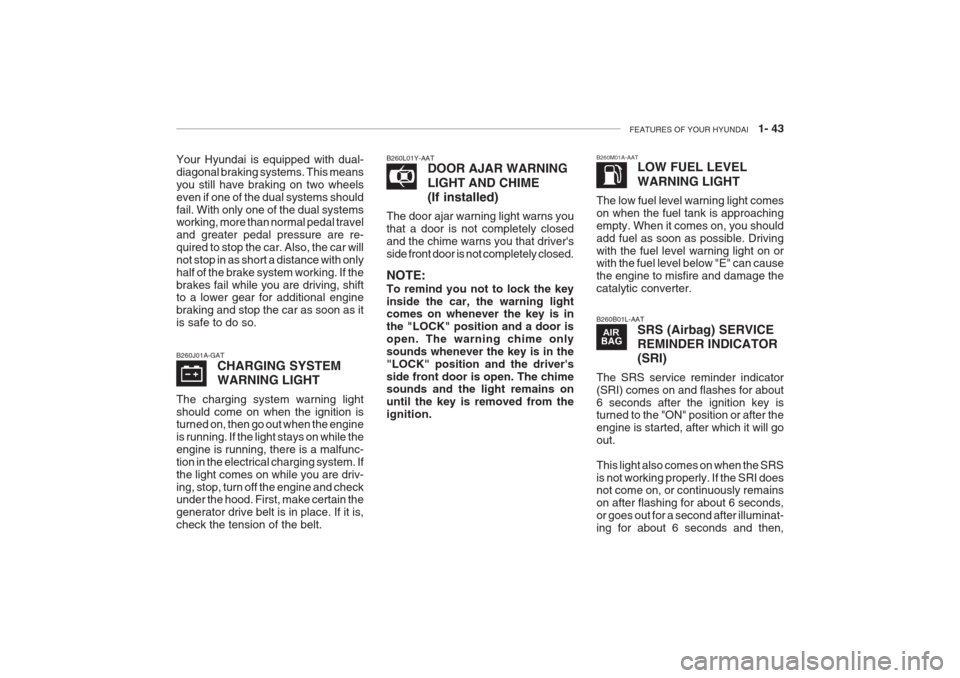
FEATURES OF YOUR HYUNDAI 1- 43
Your Hyundai is equipped with dual- diagonal braking systems. This meansyou still have braking on two wheelseven if one of the dual systems shouldfail. With only one of the dual systems working, more than normal pedal travel and greater pedal pressure are re-quired to stop the car. Also, the car willnot stop in as short a distance with onlyhalf of the brake system working. If thebrakes fail while you are driving, shift to a lower gear for additional engine braking and stop the car as soon as itis safe to do so. B260J01A-GAT
CHARGING SYSTEM WARNING LIGHT
The charging system warning light should come on when the ignition is turned on, then go out when the engine is running. If the light stays on while theengine is running, there is a malfunc-tion in the electrical charging system. Ifthe light comes on while you are driv-ing, stop, turn off the engine and check under the hood. First, make certain the generator drive belt is in place. If it is,check the tension of the belt. B260L01Y-AAT
DOOR AJAR WARNING
LIGHT AND CHIME (If installed)
The door ajar warning light warns you that a door is not completely closedand the chime warns you that driver'sside front door is not completely closed. NOTE: To remind you not to lock the key inside the car, the warning light comes on whenever the key is in the "LOCK" position and a door isopen. The warning chime onlysounds whenever the key is in the"LOCK" position and the driver'sside front door is open. The chime sounds and the light remains on until the key is removed from theignition. B260M01A-AAT
LOW FUEL LEVEL WARNING LIGHT
The low fuel level warning light comes on when the fuel tank is approachingempty. When it comes on, you shouldadd fuel as soon as possible. Drivingwith the fuel level warning light on or with the fuel level below "E" can cause the engine to misfire and damage thecatalytic converter. B260B01L-AAT SRS (Airbag) SERVICE REMINDER INDICATOR(SRI)
The SRS service reminder indicator (SRI) comes on and flashes for about6 seconds after the ignition key is turned to the "ON" position or after the engine is started, after which it will goout. This light also comes on when the SRS is not working properly. If the SRI does not come on, or continuously remains on after flashing for about 6 seconds,or goes out for a second after illuminat-ing for about 6 seconds and then,
Page 58 of 230
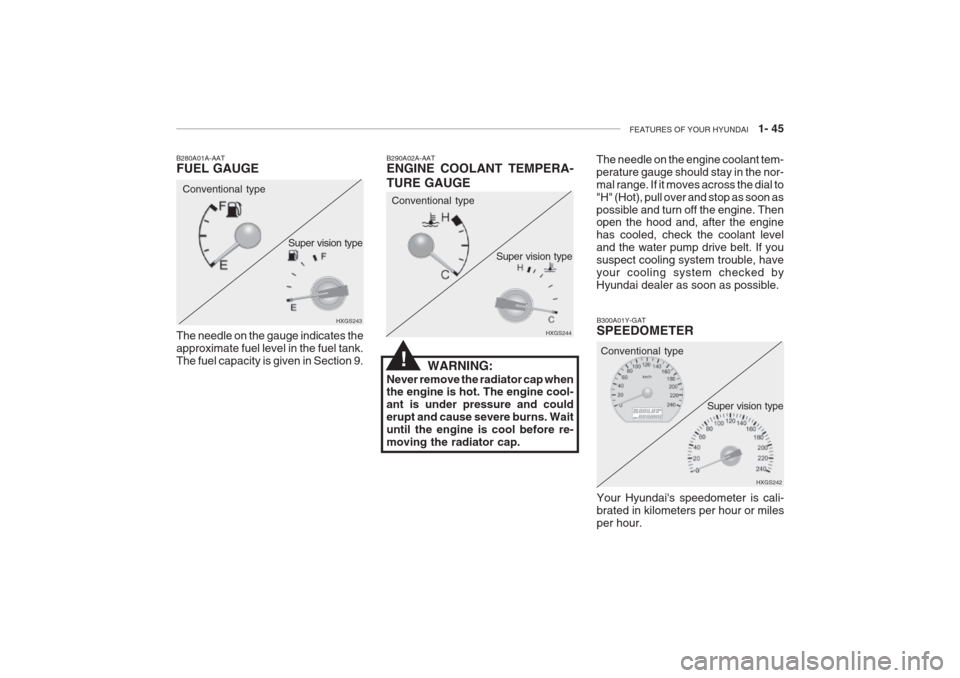
FEATURES OF YOUR HYUNDAI 1- 45
B300A01Y-GAT SPEEDOMETER Your Hyundai's speedometer is cali- brated in kilometers per hour or milesper hour. HXGS242
Conventional type
Super vision type
B280A01A-AAT FUEL GAUGE
B290A02A-AATENGINE COOLANT TEMPERA- TURE GAUGE
WARNING:
Never remove the radiator cap when the engine is hot. The engine cool- ant is under pressure and coulderupt and cause severe burns. Waituntil the engine is cool before re-moving the radiator cap.
HXGS243
HXGS244
The needle on the gauge indicates theapproximate fuel level in the fuel tank.The fuel capacity is given in Section 9. Conventional type
Conventional type
Super vision type
Super vision type
The needle on the engine coolant tem- perature gauge should stay in the nor-mal range. If it moves across the dial to"H" (Hot), pull over and stop as soon aspossible and turn off the engine. Then open the hood and, after the engine has cooled, check the coolant leveland the water pump drive belt. If yoususpect cooling system trouble, haveyour cooling system checked byHyundai dealer as soon as possible.
!
Page 67 of 230
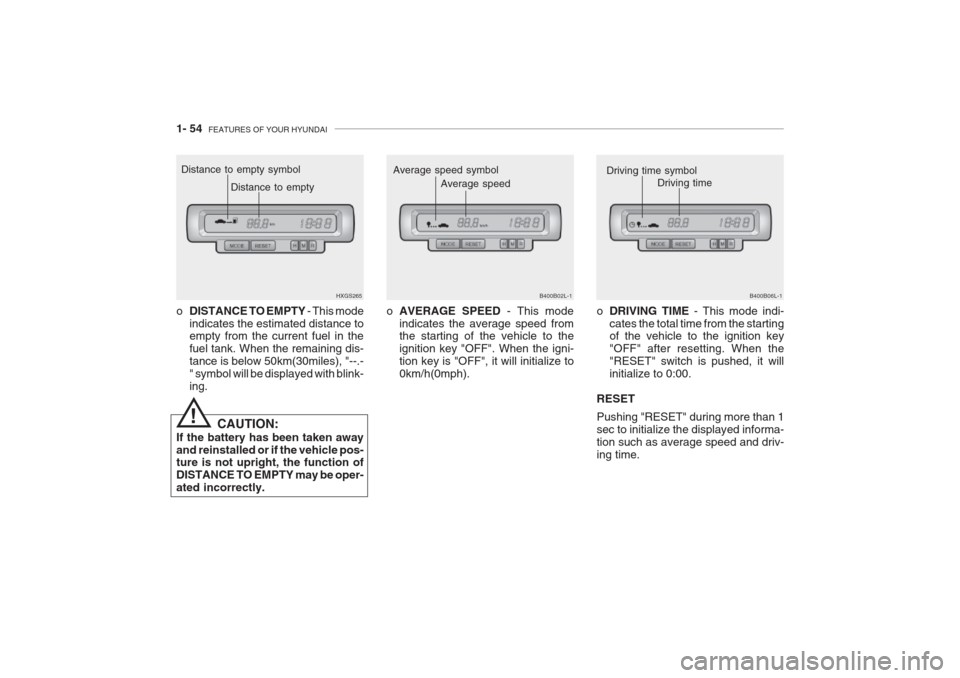
1- 54 FEATURES OF YOUR HYUNDAI
B400B06L-1
Driving time symbol
Driving time
CAUTION:
If the battery has been taken away and reinstalled or if the vehicle pos- ture is not upright, the function of DISTANCE TO EMPTY may be oper-ated incorrectly.
B400B02L-1
Average speed symbol
Average speed
oDRIVING TIME - This mode indi-
cates the total time from the starting of the vehicle to the ignition key "OFF" after resetting. When the"RESET" switch is pushed, it willinitialize to 0:00.
RESET Pushing "RESET" during more than 1 sec to initialize the displayed informa-tion such as average speed and driv-ing time.
HXGS265 oAVERAGE SPEED - This mode
indicates the average speed from the starting of the vehicle to the ignition key "OFF". When the igni-tion key is "OFF", it will initialize to0km/h(0mph).
Distance to empty symbol
Distance to empty
o DISTANCE TO EMPTY - This mode
indicates the estimated distance to empty from the current fuel in the fuel tank. When the remaining dis-tance is below 50km(30miles), "--.-" symbol will be displayed with blink-ing.
!
Page 68 of 230
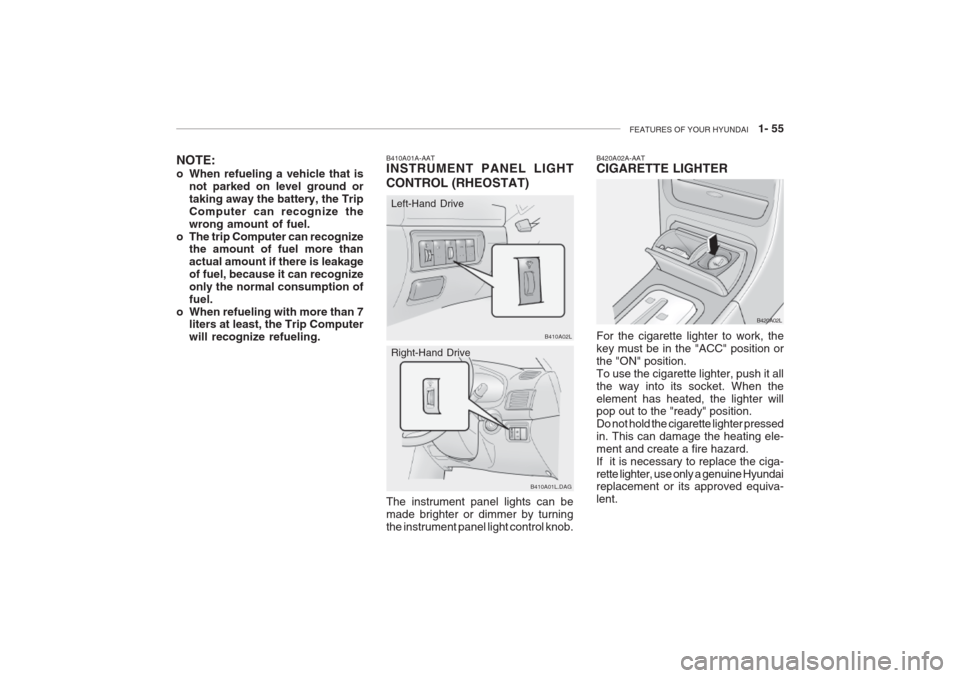
FEATURES OF YOUR HYUNDAI 1- 55
NOTE:
o When refueling a vehicle that is
not parked on level ground or taking away the battery, the TripComputer can recognize thewrong amount of fuel.
o The trip Computer can recognize the amount of fuel more thanactual amount if there is leakageof fuel, because it can recognizeonly the normal consumption offuel.
o When refueling with more than 7 liters at least, the Trip Computerwill recognize refueling.
The instrument panel lights can be made brighter or dimmer by turningthe instrument panel light control knob.Right-Hand Drive
B410A01L.DAG
B410A01A-AAT INSTRUMENT PANEL LIGHT CONTROL (RHEOSTAT)Left-Hand Drive
B410A02L B420A02L
For the cigarette lighter to work, the key must be in the "ACC" position orthe "ON" position.To use the cigarette lighter, push it allthe way into its socket. When theelement has heated, the lighter will pop out to the "ready" position. Do not hold the cigarette lighter pressedin. This can damage the heating ele-ment and create a fire hazard.If it is necessary to replace the ciga-rette lighter, use only a genuine Hyundai replacement or its approved equiva- lent.
B420A02A-AAT CIGARETTE LIGHTER
Page 80 of 230
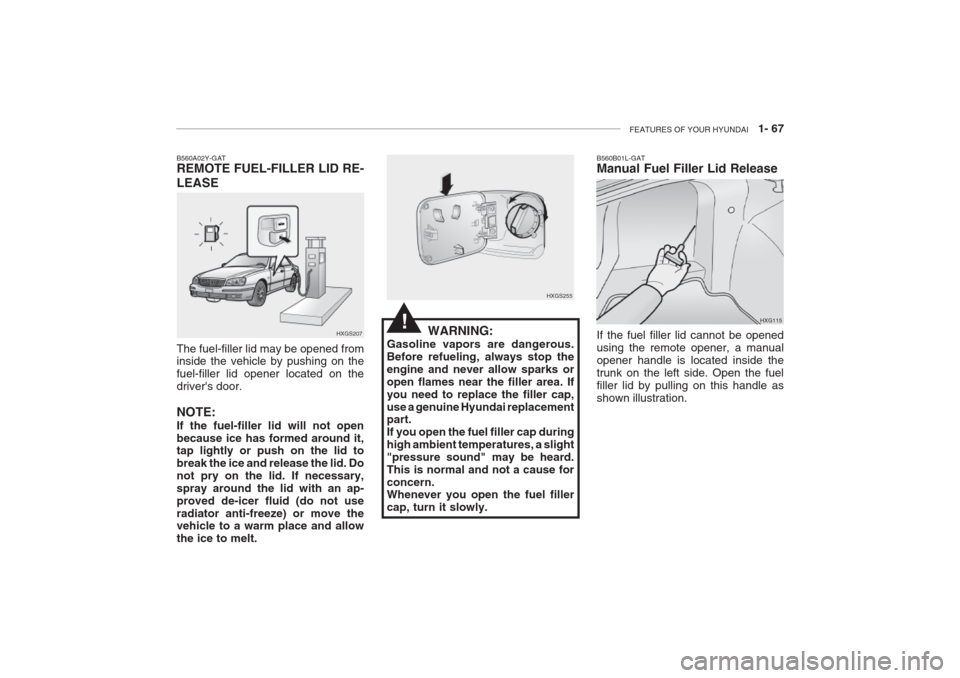
FEATURES OF YOUR HYUNDAI 1- 67
HXGS255
WARNING:
Gasoline vapors are dangerous. Before refueling, always stop theengine and never allow sparks oropen flames near the filler area. Ifyou need to replace the filler cap,use a genuine Hyundai replacement part. If you open the fuel filler cap duringhigh ambient temperatures, a slight"pressure sound" may be heard.This is normal and not a cause forconcern. Whenever you open the fuel filler cap, turn it slowly.
HXGS207
B560A02Y-GAT REMOTE FUEL-FILLER LID RE- LEASE The fuel-filler lid may be opened from inside the vehicle by pushing on the fuel-filler lid opener located on thedriver's door. NOTE: If the fuel-filler lid will not open because ice has formed around it, tap lightly or push on the lid to break the ice and release the lid. Donot pry on the lid. If necessary,spray around the lid with an ap-proved de-icer fluid (do not useradiator anti-freeze) or move the vehicle to a warm place and allow the ice to melt.
!HXG115
B560B01L-GAT Manual Fuel Filler Lid Release If the fuel filler lid cannot be opened using the remote opener, a manualopener handle is located inside thetrunk on the left side. Open the fuelfiller lid by pulling on this handle asshown illustration.
Page 132 of 230
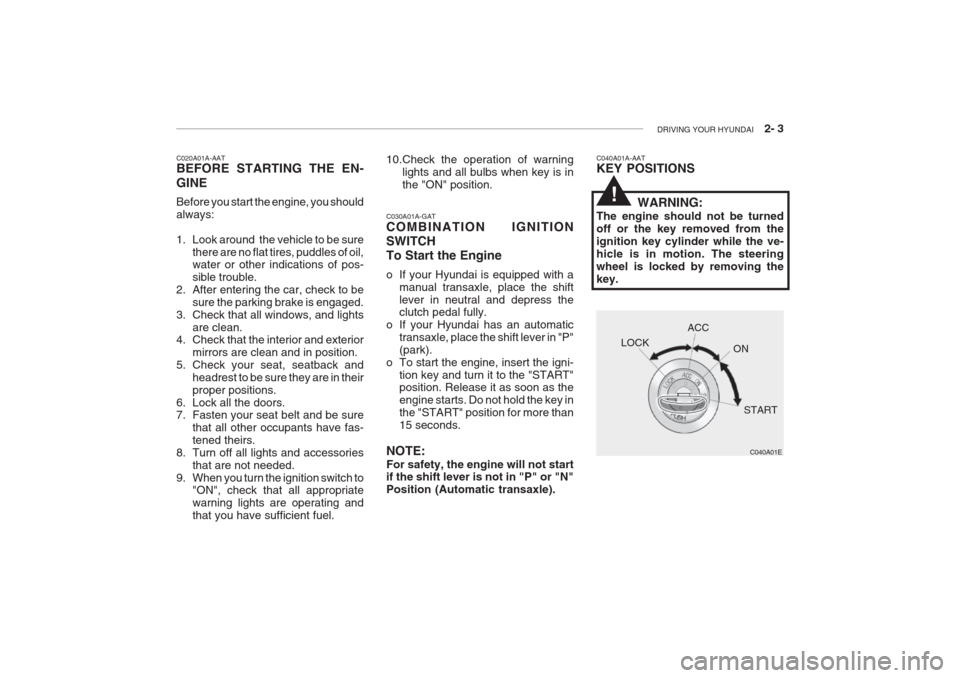
DRIVING YOUR HYUNDAI 2- 3
C020A01A-AAT BEFORE STARTING THE EN- GINE Before you start the engine, you should always:
1. Look around the vehicle to be sure
there are no flat tires, puddles of oil, water or other indications of pos- sible trouble.
2. After entering the car, check to be
sure the parking brake is engaged.
3. Check that all windows, and lights are clean.
4. Check that the interior and exterior
mirrors are clean and in position.
5. Check your seat, seatback and
headrest to be sure they are in theirproper positions.
6. Lock all the doors.
7. Fasten your seat belt and be sure
that all other occupants have fas- tened theirs.
8. Turn off all lights and accessories that are not needed.
9. When you turn the ignition switch to "ON", check that all appropriatewarning lights are operating andthat you have sufficient fuel. C030A01A-GAT COMBINATION IGNITION SWITCHTo Start the Engine
o If your Hyundai is equipped with a
manual transaxle, place the shift lever in neutral and depress the clutch pedal fully.
o If your Hyundai has an automatic
transaxle, place the shift lever in "P" (park).
o To start the engine, insert the igni- tion key and turn it to the "START" position. Release it as soon as the engine starts. Do not hold the key inthe "START" position for more than15 seconds.
NOTE: For safety, the engine will not start if the shift lever is not in "P" or "N" Position (Automatic transaxle).
10.Check the operation of warning
lights and all bulbs when key is inthe "ON" position.C040A01A-AAT KEY POSITIONS
WARNING:
The engine should not be turned off or the key removed from theignition key cylinder while the ve-hicle is in motion. The steeringwheel is locked by removing thekey.
C040A01E
LOCK
ACC
ON
START
!
Page 135 of 230

2- 6 DRIVING YOUR HYUNDAI
C070D02A-AAT Good Driving Practices
o Never take the car out of gear and
coast down a hill. This is extremely hazardous. Always leave the car ingear.
o Don't "ride" the brakes. This can cause them to overheat and mal-function. Instead, when you are driv-ing down a long hill, slow down andshift to a lower gear. When you dothis, engine braking will help slowthe car.
o Slow down before shifting to a lower
gear. This will help avoid over-rev-ving the engine, which can causedamage.
o Slow down when you encounter
cross winds. This gives you much better control of your car.
o Be sure the car is completely stopped
before you attempt to shift into re- verse. The transaxle can be dam-aged if you do not. To shift intoreverse, depress the clutch, move the shift lever to neutral, wait three seconds, then shift to the reverseposition.
C070B01A-AAT Using the Clutch The clutch should be pressed all the way to the floor before shifting, thenreleased slowly. The clutch pedalshould always be used after fully re- turning to the original position. Do not rest your foot on the clutch pedal whiledriving. This can cause unnecessarywear. Do not partially engage the clutchto hold the car on an incline. Thiscauses unnecessary wear. Use the parking brake to hold the car on an incline. Do not operate the clutch pedalrapidly and repeatedly. CAUTION:
When downshifting from fifth gearto fourth gear, caution should betaken not to inadvertently press thegear lever sideways in such a man-ner that second gear is engaged. Such a drastic downshift may cause the engine speed to increase to thepoint that the tachometer will enterthe red-zone. Such over-revving ofthe engine may possibly cause en-gine damage. C070E03A-GAT RECOMMENDED SHIFT POINTS
1-2 2-33-4 4-5
Shift
from-to Recommended
20 km/h (15 mph) 40 km/h (25 mph) 55 km/h (35 mph) 75 km/h (45 mph)
The shift points as shown above are recommended for optimum fueleconomy and performance.
!
Page 143 of 230
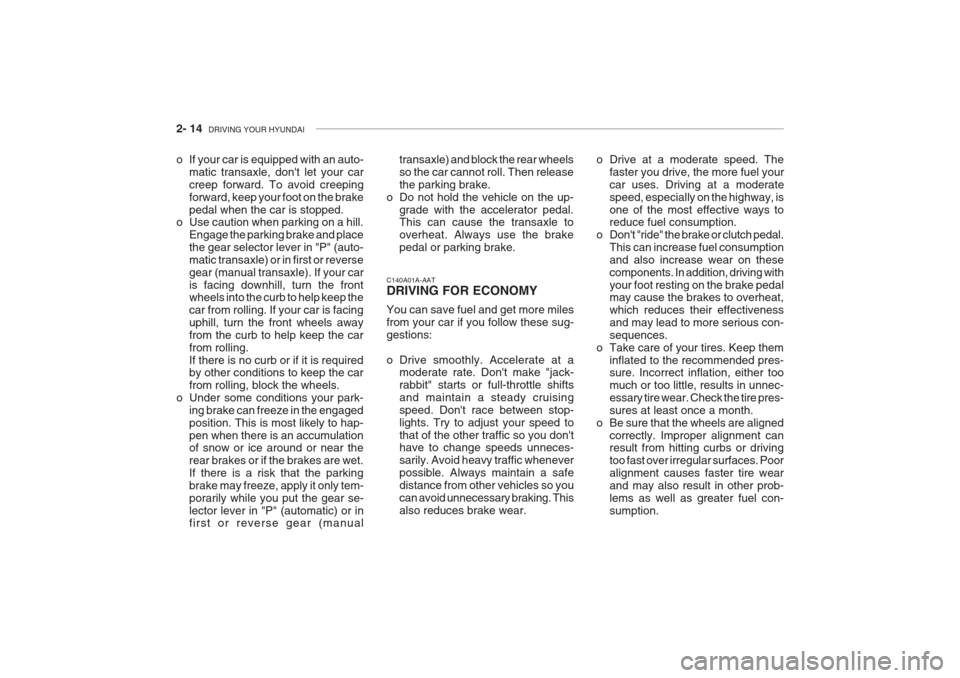
2- 14 DRIVING YOUR HYUNDAI
o Drive at a moderate speed. The
faster you drive, the more fuel your car uses. Driving at a moderatespeed, especially on the highway, isone of the most effective ways to reduce fuel consumption.
o Don't "ride" the brake or clutch pedal. This can increase fuel consumption and also increase wear on thesecomponents. In addition, driving withyour foot resting on the brake pedal may cause the brakes to overheat, which reduces their effectivenessand may lead to more serious con-sequences.
o Take care of your tires. Keep them
inflated to the recommended pres- sure. Incorrect inflation, either too much or too little, results in unnec-essary tire wear. Check the tire pres-sures at least once a month.
o Be sure that the wheels are aligned correctly. Improper alignment can result from hitting curbs or driving too fast over irregular surfaces. Pooralignment causes faster tire wearand may also result in other prob-lems as well as greater fuel con-sumption.
transaxle) and block the rear wheelsso the car cannot roll. Then releasethe parking brake.
o Do not hold the vehicle on the up- grade with the accelerator pedal. This can cause the transaxle to overheat. Always use the brakepedal or parking brake.
C140A01A-AAT DRIVING FOR ECONOMY You can save fuel and get more miles from your car if you follow these sug-gestions:
o Drive smoothly. Accelerate at a moderate rate. Don't make "jack- rabbit" starts or full-throttle shiftsand maintain a steady cruisingspeed. Don't race between stop-lights. Try to adjust your speed tothat of the other traffic so you don't have to change speeds unneces- sarily. Avoid heavy traffic wheneverpossible. Always maintain a safedistance from other vehicles so youcan avoid unnecessary braking. Thisalso reduces brake wear.
o If your car is equipped with an auto-
matic transaxle, don't let your carcreep forward. To avoid creepingforward, keep your foot on the brake
pedal when the car is stopped.
o Use caution when parking on a hill.
Engage the parking brake and placethe gear selector lever in "P" (auto-matic transaxle) or in first or reversegear (manual transaxle). If your caris facing downhill, turn the front wheels into the curb to help keep the car from rolling. If your car is facinguphill, turn the front wheels awayfrom the curb to help keep the carfrom rolling.If there is no curb or if it is required by other conditions to keep the car from rolling, block the wheels.
o Under some conditions your park-
ing brake can freeze in the engagedposition. This is most likely to hap-pen when there is an accumulation of snow or ice around or near the rear brakes or if the brakes are wet.If there is a risk that the parkingbrake may freeze, apply it only tem-porarily while you put the gear se-lector lever in "P" (automatic) or in first or reverse gear (manual